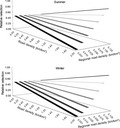- Record: found
- Abstract: found
- Article: found
Functional response of wolves to human development across boreal North America

Read this article at
Abstract
Aim
The influence of humans on large carnivores, including wolves, is a worldwide conservation concern. In addition, human‐caused changes in carnivore density and distribution might have impacts on prey and, indirectly, on vegetation. We therefore tested wolf responses to infrastructure related to natural resource development (i.e., human footprint).
Location
Our study provides one of the most extensive assessments of how predators like wolves select habitat in response to various degrees of footprint across boreal ecosystems encompassing over a million square kilometers of Canada.
Methods
We deployed GPS‐collars on 172 wolves, monitored movements and used a generalized functional response (GFR) model of resource selection. A functional response in habitat selection occurs when selection varies as a function of the availability of that habitat. GFRs can clarify how human‐induced habitat changes are influencing wildlife across large, diverse landscapes.
Results
Wolves displayed a functional response to footprint. Wolves were more likely to select forest harvest cutblocks in regions with higher cutblock density (i.e., a positive functional response to high‐quality habitats for ungulate prey) and to select for higher road density in regions where road density was high (i.e., a positive functional response to human‐created travel routes). Wolves were more likely to use cutblocks in habitats with low road densities, and more likely to use roads in habitats with low cutblock densities, except in winter when wolves were more likely to use roads regardless of cutblock density.
Main conclusions
These interactions suggest that wolves trade‐off among human‐impacted habitats, and adaptively switch from using roads to facilitate movement (while also risking encounters with humans), to using cutblocks that may have higher ungulate densities. We recommend that conservation managers consider the contextual and interacting effects of footprints when assessing impacts on carnivores. These effects likely have indirect impacts on ecosystems too, including on prey species.
Abstract
We deployed GPS‐collars on 172 wolves and evaluated resource selection across boreal ecosystems encompassing over a million square kilometers of North America. Wolves traded‐off among human impacted habitats, and more specifically adaptively switch from using roads to facilitate movement (while also risking encounters with humans), to using cutblocks that may have higher ungulate densities. We therefore recommend that conservation managers consider the contextual and interacting effects of human footprints when assessing impacts on carnivores and on their prey.
Related collections
Most cited references50
- Record: found
- Abstract: not found
- Article: not found
Predation, apparent competition, and the structure of prey communities
- Record: found
- Abstract: found
- Article: not found
Application of random effects to the study of resource selection by animals.
- Record: found
- Abstract: not found
- Article: not found
